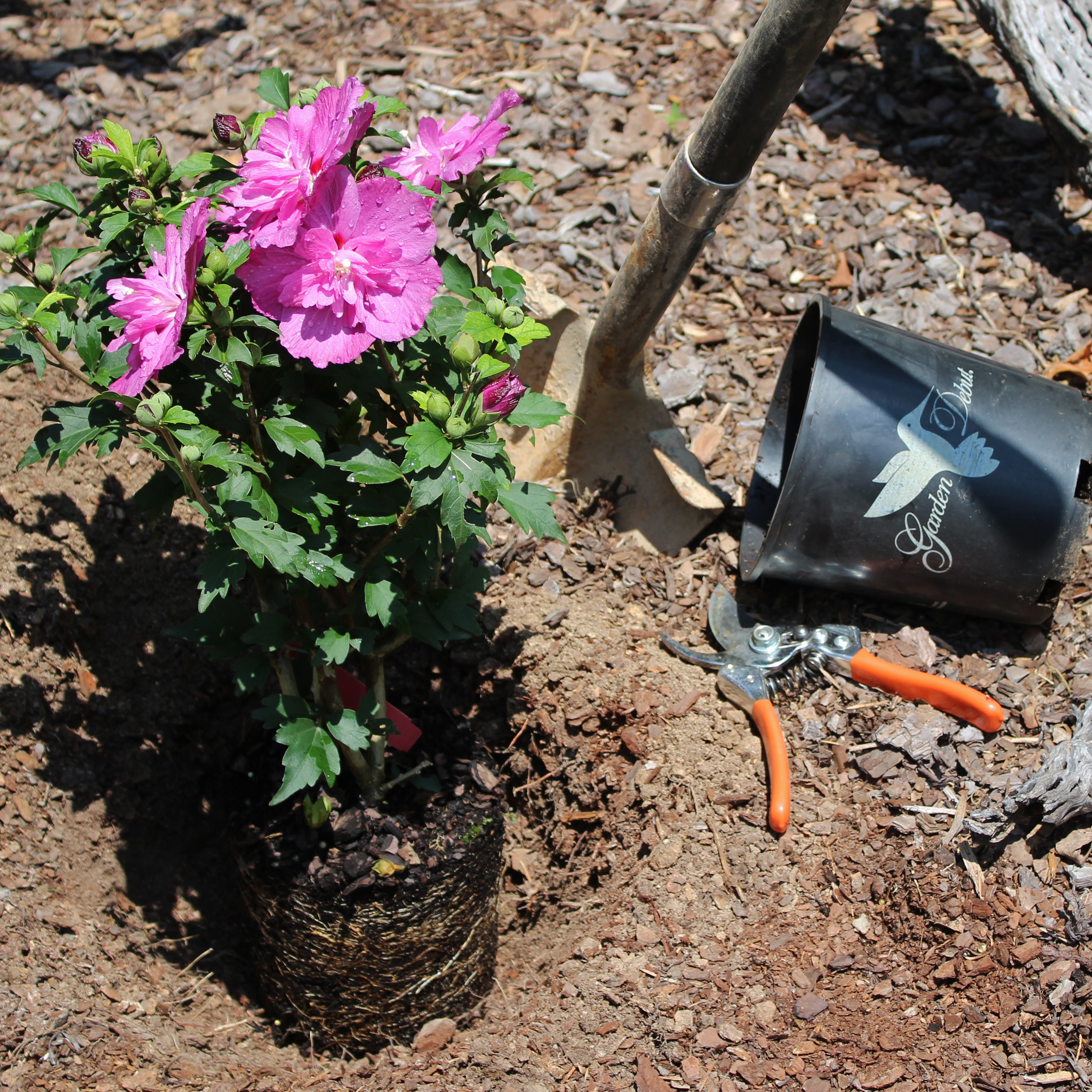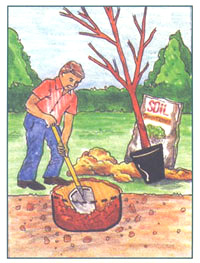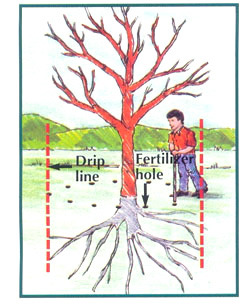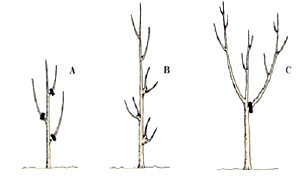
Planting Instructions
 DIGGING THE HOLE
|
 A PROPERLY PLANTED TREE
|
First, start by digging a hole twice as wide, and about one inch deeper than the depth of the pot or root ball. Fill the hole with water, if the water remains in the hole longer than 30 minutes. Find a better draining location. Without opening the fertilizer packet (supplied with some Imagine Backyard Trees®), place entire packet of fertilizer in the bottom of the hole and cover with one inch of soil. Don't replace rocks into the hole.
Gently remove the tree from the plastic pot by holding the tree at the base of the trunk and pushing on the rim of the pot. If the tree will not come out easily, check for roots coming out of drain holes. Place the tree in the center of the hole and replace all remaining soil. Do not plant the tree root ball any deeper than the original soil grade. If you bury the trunk of the tree you can kill the tree.

WATERING
Form a ring of soil around the tree. This will help to hold water. Water until soil is thoroughly wet and all air pockets are removed. Remove grass and or weeds and mulch around your tree with a three foot circle. Your mulch ring should look like a donut, not a volcano.
Piling mulch around the trunk of your tree will kill the tree. Water your tree twice week during the first growing season, and once a week during the first dormant season. If you live in a climate that does not receive much snow in the winter months, don't forget to water, your trees also need water when dormant.
AFTER PLANTING CARE:
FIRST SEASON

STAKING AND GUYING
All young trees should be staked or guyed to avoid being whip by the wind. Trees not secured will have a very tough time rooting into the native soil. As the wind whips them around the small hair roots that feed and anchor the tree will continue to be broken off. Small trees should be tied to a wooded, bamboo, or steel tree stake placed beside the tree and tied to it using a stretchable material. I recommend using tree stakes to stabilize, maintain a straight trunk and for securing and training a central leader. Once the tree has grown and established a straight trunk and the central leader is above the desired height, remove the stake to avoid rubbing damage to the tree.
When using rope or wire to stake or guy trees, always pad the tree, using a piece of old garden hose to avoid cutting into the tree and damaging the trunk. It is a good idea to use a trunk guard on the tree to protect from sun scald, weed-eaters, mowers, and pet leashes.

FERTILIZING AND FEEDING
It is important to think of fertilizer as nutrition, not as medicine. Keeping your tree properly fertilized will help in controlling insect and diseases as well as maintaining faster and stronger growth.
We recommend feeding your tree at planting time with a slow release fertilizer buried beneath the root ball of the tree. A dilute liquid fertilizer can also be used occasionally during the first growing season. In the early spring of the second season we recommend using a slow release fertilizer buried around the drip line of the tree. One tablespoon of fertilizer per hole for each year the tree has been planted will be sufficient. A dilute liquid fertilizer can also be used occasionally.
If you would like to purchase our recommended packets of slow release fertilizer for all your trees and shrubs click here.

SPRAYING
Proper care and maintenance, which includes good watering and fertilizing practices, will result in healthy, vigorous specimen trees that can simply ward off most diseases. Many insects can simply be picked off and destroyed. Nature has supplied us with one of the best methods of bug control---BIRDS.
Birds are beneficial and should be encouraged to visit your landscape. If you are unsure about a disease or insect, contact your local qualified garden center for a diagnosis and recommended spray.
PRUNING

Young and newly planted trees should not be heavily pruned, unless damaged or broken branches exist, if so, remove with sharp and clean pruning shears. Keep in mind, every leaf on your tree is a food factory. Removing too many leaves at one time will stress the tree and may cause it to die. Remember the one third rule, never remove more than one third of a plant's foliage at a time. Once your tree is established and showing new growth, light corrective prunings are encouraged. As the diagram above illustrates, maintaining a central leader is very important. Remove any side branches competing with the central leader. Light pruning throughout the season is much better than severe pruning.
SECOND SEASON PRUNING
 Lighter pruning for a fuller tree
|
 Heavy pruning for a more open canopy
|
Second season pruning is often the most important. As your tree has now become established and rooted well into the native soil, you will see a tremendous amount of growth this season. If new branches are left alone to become too heavy, they can break off and cause damage to the tree. During mid winter prune any damaged or crossing branches and maintain central leader.
As your tree begins to grow prune back branches that may become to heavy. Lightly pruning side branches will also cause the tree to become fuller. If you regularly prune out broken, diseased or crossing branches, you will avoid future problems and have a healthy, attractive tree.
THIRD AND FOURTH SEASON PRUNING
 BEFORE PRUNING
Remove broken or damaged branches
|
 AFTER PRUNING
A well pruned tree
|
During the third and fourth year of a trees life the scaffold branches require your attention. As the tree grows taller select the scaffold branches among the many branches the tree has produced. Select branches from around the tree so that light and air will freely reach the leaves on each branch.
For smaller trees like Japanese Maples the space between scaffold branches should be 8 or 12 inches apart, and for large trees like Oaks space the branches 18 to 36 inches apart.
